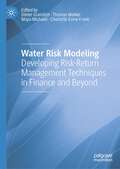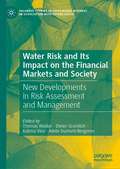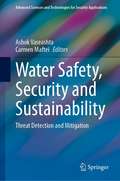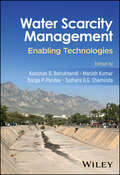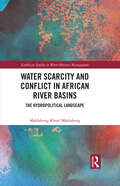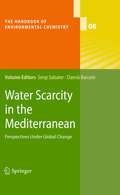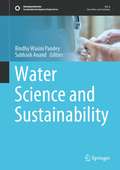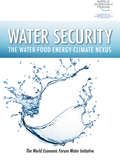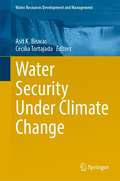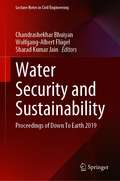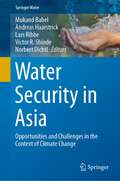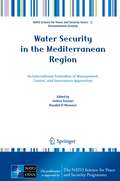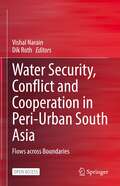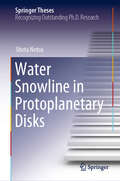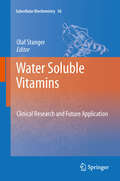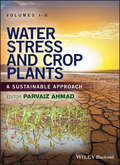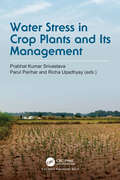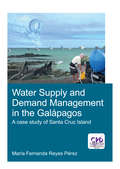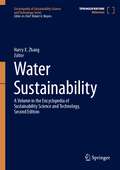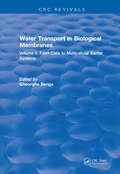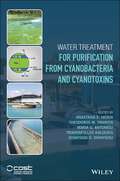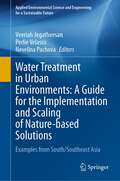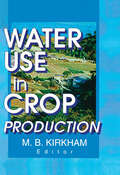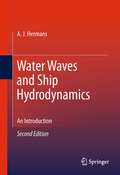- Table View
- List View
Water Risk Modeling: Developing Risk-Return Management Techniques in Finance and Beyond
by Thomas Walker Dieter Gramlich Maya Michaeli Charlotte Esme FrankThis book sheds light on the topic of financial water risk by examining the modeling challenges associated with physical, regulatory, and reputational water risk in finance. It explores various approaches to operationalize water risk from a financial analysis, investment management, and climate science perspective. The analysis of tools to assess water risk provides the basis for the development of appropriate risk-return management techniques in finance and beyond. This book provides new insights by focusing on financial water threats and their related opportunities. It will be of interest to both academics and practitioners who work at the interface of finance, economics, nature, and society.
Water Risk and Its Impact on the Financial Markets and Society: New Developments in Risk Assessment and Management (Palgrave Studies in Sustainable Business In Association with Future Earth)
by Thomas Walker Dieter Gramlich Kalima Vico Adele Dumont-BergeronWater risks, including the lack of access to fresh water for personal and industrial use, droughts, floods, and water contamination, are problems that are not new, yet, they are amplifying in the face of climate change, population growth, and rapid economic development. Properly identifying, measuring, and managing these risks as well as taking advantage of related mitigation opportunities is essential for the future well-being of firms across various industries, investors who invest in these firms, local and federal governments, and ultimately our society as a whole. This edited book sheds light on this topic by examining the unique measurement and modelling challenges associated with either the scarcity or overabundance of water and their interaction with finance and society. Specifically, it explores approaches to assess and operationalize water risk, examines the vulnerability of institutions and markets, and discusses strategies for risk mitigation.
Water Safety, Security and Sustainability: Threat Detection and Mitigation (Advanced Sciences and Technologies for Security Applications)
by Ashok Vaseashta Carmen MafteiThis book focuses on threats, especially contaminants, to drinking water and the supply system, especially in municipalities but also in industrial and even residential settings. The safety, security, and suitability landscape can be described as dynamic and complex stemming from necessity and hence culpability due to the emerging threats and risks, vis-a-vis globalization resulting in new forms of contaminants being used due to new technologies. The book provides knowledge and guidance for engineers, scientists, designers, researchers, and students who are involved in water, sustainability, and study of security issues. This book starts out with basics of water usage, current statistics, and an overview ofwater resources. The book then introduces different scenarios of safety and security and areas that researchers need to focus. Following that, the book presents different types of contaminants – inadvertent, intentional, or incidental. The next section presents different methodologies of contamination sensing/detection and remediation strategies as per guidance and standards set globally. The book then concludes with selected chapters on water management, including critical infrastructure that is critical to maintaining safe water supplies to cities and municipalities. Each chapter includes descriptive information for professionals in their respective fields. The breadth of chapters offers insights into how science (physical, natural, and social) and technology can support new developments to manage the complexity resident within the evolving threat and risk landscape.
Water Scarcity Management: Enabling Technologies
by Manish Kumar Kanchan D. Bahukhandi Durga P. Panday Tushara G.G. ChamindaAuthoritative, forward-thinking resource presenting strategies and technologies to mitigate water scarcity and improve water quality Founded on the idea that conventional procedures are unsuccessful in providing a solution to water security as a whole, Water Scarcity Management delivers integrated, cross-cutting approaches to solve some of the biggest problems that the world faces in terms of freshwater through a nature-based approach. Written by a team of authors and leaders in the field of environmental science and technology, this book explores topics including: Water availability, management, governance, and quality and policy development in the AnthropoceneNew global trends of water management and wastewater reuse, as well as novel integrated strategies and technologies for the mitigation of biotic and abiotic emerging contaminantsWater stress due to decades of poor management, over-extraction of groundwater, and contamination of freshwater suppliesRising demand of freshwater due to rapid population growth, urbanization, and increasing needs across sectors including agriculture, industry, and energy Water Scarcity Management is a timely, essential, forward-thinking resource on the subject for environmental engineers, microbiologists, environmental scientists, policy developers and modelers seeking to integrate findings on water scarcity, availability, management, reuse, conservation, and treatment into policy development.
Water Scarcity and Conflict in African River Basins: The Hydropolitical Landscape (Earthscan Studies in Water Resource Management)
by Mahlakeng Khosi MahlakengThe book presents a critical and comparative analysis of the hydropolitical landscape of African transboundary river basins which, for much of the past century, have been affected by water scarcity. River and lake basins can become a source of tension and conflict due to a complicated mix of environmental, demographic, diplomatic, historical and geopolitical factors. This book, however, specifically focuses on the important, and often under looked, role played by scarcity in generating or exacerbating conflicts in shared river basins. Asserting that transboundary river basins tie states into a web of interdependence, this book raises awareness of how water scarcity, or the depletion of water resources, complicates this relationship as nations are forced to look beyond their own borders to meet the demand for water to satisfy multiple needs. Taking a comparative approach, it examines three shared basins: the Orange-Senqu, the Nile and the Niger River basins. While situated in different regions, all three basins are marked by serious environmental challenges that are detrimental to combustible hydropolitics over such shared water resources and they provide fascinating insights into the links between climate variability and change, water resources, human security, conflict, adaptation and regime capacity. Overall, this book argues that conflict over transboundary resources can be prevented given the establishment of norms, rules, and the role of external actors that help regulate state behaviour and control their impacts. This book will be of great interest to students and scholars of water resource management, hydropolitics, environmental conflict, resource scarcity and international relations. It will also be of interest to policymakers involved in transboundary water resource governance.
Water Scarcity in the Mediterranean
by Sergi Sabater Damià BarcelóWater scarcity affects hydrologic resources, systems connectivity, biodiversity, water quality, and river ecosystem functioning. It has direct impacts on economic sectors that use and depend on water, such as agriculture, tourism, industry, energy and transport. The Mediterranean Basin is one of the regions in the world most vulnerable to climate changes, as well as one of the most impacted by human water demand. This volume provides an in-depth view of the water quality and quantity implications of water scarcity. It highlights its possible causes and describes the effects in regions under Mediterranean climate. The topics covered include climate effects, water resources (use, storage and new sources), water quality (chemical and microbiological), and the effects on ecosystems suffering from water scarcity. This book is addressed to scientists and students, but also to managers involved in the necessary decision making process to face future periods of drought.
Water Science and Sustainability (Sustainable Development Goals Series)
by Subhash Anand Bindhy Wasini PandeyThis book describes the importance of water resources for socio-economic and ecological development including geomorphic and ecological environments. Hence, conservation, management and development of water resources have become necessary for the all-around development of global populations and the environment. It is the outcome of valuable contributions made by eminent scientists and research scholars who have developed alternative strategies, solutions and models for sustainable water resources through research, monitoring and experiments varying from regional to global scale. This book is of immense use to the policymakers, environmentalists, ecologists, academician, research scholars and people in general concerned with water resources management.
Water Security
by Water Initiative The World Economic ForumAt the 2008 Davos Annual Meeting, UN Secretary General Ban Ki-Moon identified water as "the climate adaptation issue," directing the World Economic Forum to assemble the world's foremost group of public, private, non-governmental-organization and academic experts to examine the impending global water crisis from all perspectives. The result of their work is this forecast--a stark, non-technical overview of where we will be by 2025 if we continue to (mis)manage our water resources. Water Security contains compelling commentary from leading decision-makers, past and present. The commentary is supported by analysis from leading academics of how the world economy will be affected if world leaders cannot agree on solutions. The findings are shocking. Perhaps equally stunning are the potential solutions and the recommendations that the group presents. All are included in this landmark publication.
Water Security Under Climate Change (Water Resources Development and Management)
by Asit K. Biswas Cecilia TortajadaThis book highlights the likely impacts of climate change in terms of global and national water securities, how different countries are attempting to address these complex problems and to what extent they are likely to succeed. A major global concern at present, especially after the social and economic havoc that has been caused by COVID-19 in only one year, is how we can return to earlier levels of economic development patterns and then further improve the process so that sustainable development goals are reached to the extent possible by 2030, in both developed and developing countries. Mankind is now facing two existential problems over the next several decades. These are climate change and whether the world will have access to enough water to meet all its food, energy, environment and health needs. Much of expected climate change impacts can be seen through the lens of extreme hydrological events, like droughts, floods and other extreme hydrometeorological events.Chapter 7 is available open access under a Creative Commons Attribution 4.0 International License via link.springer.com.Chapter 12 is available open access under a Creative Commons Attribution-NonCommercial 4.0 International License via link.springer.com.
Water Security and Sustainability: Proceedings of Down To Earth 2019 (Lecture Notes in Civil Engineering #115)
by Wolfgang-Albert Flügel Chandrashekhar Bhuiyan Sharad Kumar JainThis book contains selected peer-reviewed papers presented in the International Conference Down To Earth 2019, and is focused on Water Security and Sustainability. The topics covered in this book include sustainability of water resources, geospatial modelling and hydro-informatics, extreme hydrology (drought and flood), adaptation to climate-change impacts, vulnerability-risk-reliability-resilience, and hydrological risks in north-east India. The book also discusses innovative techniques and technologies for water resources assessment and management. Enriched with numerous case studies covering diverse topics, the book can be valuable for students, researchers, as well as industry professionals interested in water resources assessment, management and sustainable development.
Water Security in Asia: Opportunities and Challenges in the Context of Climate Change (Springer Water)
by Norbert Dichtl Lars Ribbe Mukand Babel Andreas Haarstrick Victor R. ShindeThis book assesses the current water-security situation in Asia. The thematic areas of the book discuss the United Nation’s sustainable development goals with a particular focus on Goal 6 (“Ensure availability and sustainable management of water and sanitation”) and Goal 13 (“Take urgent action to combat climate change and its impacts”). Asia has been facing a number of water-related challenges for decades due to multiple factors such as increasing population, socio-economic development, urbanization and migration, and climate change now poses an additional threat. While significant efforts have been made by governments in Asia, much more work is needed to make Asian societies water-secure. Given its multi-disciplinary approach, the book is a valuable resource for researchers involved in the further development of water-security concepts, approaches, and methodologies. In addition, it helps policymakers, planners, and practitioners to formulate sustainable water- security enhancement strategies grounded in sound scientific evidence to protect human well-being.
Water Security in the Mediterranean Region
by Andrea Scozzari Bouabid El MansouriThe role of water in our communities, from local to regional and right up to global levels, poses a series of key questions about climate change, about the anthropogenic impact on the environment, and about all the interconnected actions and events that affect the availability and quality of the resource. All these questions share a common demand for more scientific knowledge and information. In this particular context the disciplinary boundaries are fading, and there is a growing need to create broader connections and wider collaborative interdisciplinary groups, aimed at building an integrated knowledge-base to serve not only stakeholders but also the whole of society. Only in this way can we hope to respond effectively to the challenges and changing dynamics of human-hydrologic systems. Following this concept, contributors from multiple disciplinary backgrounds, such as Law Studies, Hydrogeology, Monitoring and Information Technologies, Geophysics, Geochemistry, Environmental Sciences, Systems Engineering, Economics and Social Studies, joined forces and interacted in this workshop. The present book reports the proceedings of this three-day ARW (Advanced Research Workshop), and explores different aspects of the environmental security assessment process, focusing on the assessment, monitoring and management of water resources, and giving an overview of the related scientific knowledge.
Water Security, Conflict and Cooperation in Peri-Urban South Asia: Flows across Boundaries
by Vishal Narain Dik RothThis open access book explores the implications of urbanization in South Asia for water (in-) security in the peri-urban spaces of Dhaka and Khulna in Bangladesh, Bengaluru, Gurugram, Hyderabad, Kolkata and Pune in India, and Kathmandu Valley in Nepal. The book looks into specifically peri-urban water security issues in a context of rapid urbanization and social-environmental changes, including the changing climate and its emerging impacts. It demonstrates how urbanization processes change water flows between rural and urban areas, the implications of this processes for the water security of peri-urban populations, and how new institutions and technologies develop to mediate the relationships between peri-urban communities and water. The book seeks to further the debate on peri-urban water security, including what constitutes the peri-urban, socially differentiated access to water in peri-urban spaces, interventions for improving water access, and emerging forms of cooperation and conflict related to water access in a context of urbanization and climate change. As such, this book is an interesting read for academics with various disciplinary backgrounds, professionals working in the worlds of national and international policy, NGOs, activist groups, research and development institutes, and individual readers interested in water security and urbanization.
Water Snowline in Protoplanetary Disks (Springer Theses)
by Shota NotsuThis book presents pioneering work on a critical observational test of the planet formation theory based on the theoretical study of the water snowline, beyond which water takes the form of ice, in the protoplanetary disks – the place where planets are formed. Since the water snowline is thought to divide the regions of rocky and gas-giant planet formation, the location of the snowline is essential for the planet formation process. The book proposes a novel method to locate the snowlines using high-dispersion spectroscopic observations of water vapor lines, which is based on in sophisticated chemical modeling and line radiative transfer calculations. The author obtained the water vapor distribution in the disks using the chemical reaction network, which includes photoreactions and gas–grain interactions. The simulated transition lines of water vapor in the disks demonstrate that relatively weak transition lines with moderate excitation energies are the best tracers of water snowline. Furthermore, the author observed submillimeter lines of water vapor in a disk using ALMA (Atacama Large Millimeter/submillimeter Array) to obtain the upper limit of the line fluxes with the highest sensitivity to date. These unprecedented findings are important in locating the snowlines in the disks, and the method goes a long way toward achieving a comprehensive understanding of the planet formation processes as well as of the origin of water on rocky planets, including our Earth, based on future observations using ALMA and SPICA (Space Infrared Telescope for Cosmology and Astrophysics).
Water Soluble Vitamins
by Olaf StangerThe discovery of vitamins in the early 1900s, their later chemical characterization and the clarification of pivotal metabolic functions are sequential aspects of a brilliant chapter in the history of modern nutritional sciences and medicine. The name, derived from "vital-amines", indicates their elementary metabolic key functions in human metabolism. Vitamins are truly families of compounds, which include precursors and various free and bound forms, all with individual roles in metabolism and function. A more recent approach therefore searches for the components, the understanding of their roles in physiology and pathology as well as looking for novel pharmacological applications. When used properly, vitamins are, indeed, "magical" substances. Due to their efficacy, they should therefore be regarded as drugs with effects and side effects to be weighted against each other. Today, it is not the previously fatal deficiency-associated diseases that are in the focus of interest, but rather the relation of suboptimal vitamin bioavailability to chronic disease. This is complicated by genetic susceptibility, lifestyle, and the presence or absence of health-compromising habits, such as smoking. In turn, the development and application of new and more sensitive and specific assays further enable us to look more closely into the many functions of vitamins. Water soluble vitamins are complex molecular structures and even today, many areas in vitamin biochemistry are not yet fully understood. Novel effects and functions of vitamins remain and continue to be discovered. This book presents most recent research results and fascinating new knowledge on the role and effects of the water soluble vitamins in man. Some of the most distinguished chemists, biochemists, biologists and clinicians have contributed valuable chapters sharing unexpected novel insights into the biochemistry, (epi)genetics, metabolism, and function of water soluble vitamins, with their potential for clinical applications. Thus, physicians, clinicians, scientists, researchers, epidemiologists. nutritional specialists and health professionals alike will find stimulating and fascinating new insight in the many roles that water soluble vitamins play in human health and disease.
Water Stress and Crop Plants: A Sustainable Approach, 2 Volume Set
by Parvaiz AhmadPlants are subjected to a variety of abiotic stresses such as drought, temperature, salinity, air pollution, heavy metals, UV radiations, etc. To survive under these harsh conditions plants are equipped with different resistance mechanisms which vary from species to species. Due to the environmental fluctuations agricultural and horticultural crops are often exposed to different environmental stresses leading to decreased yield and problems in the growth and development of the crops. Drought stress has been found to decrease the yield to an alarming rate of some important crops throughout the globe. During last few decades, lots of physiological and molecular works have been conducted under water stress in crop plants.Water Stress and Crop Plants: A Sustainable Approach presents an up-to-date in-depth coverage of drought and flooding stress in plants, including the types, causes and consequences on plant growth and development. It discusses the physiobiochemical, molecular and omic approaches, and responses of crop plants towards water stress. Topics include nutritional stress, oxidative stress, hormonal regulation, transgenic approaches, mitigation of water stress, approaches to sustainability, and modern tools and techniques to alleviate the water stress on crop yields. This practical book offers pragmatic guidance for scientists and researchers in plant biology, and agribusinesses and biotechnology companies dealing with agronomy and environment, to mitigate the negative effects of stress and improve yield under stress. The broad coverage also makes this a valuable guide enabling students to understand the physiological, biochemical, and molecular mechanisms of environmental stress in plants.
Water Stress in Crop Plants and Its Management
by Parul Parihar Prabhat Kumar Srivastava Richa UpadhyayThe book provides an overview of water stress in plants and alterations in the physiology, morphology, anatomy, and molecular mechanism due to water stress. The induction of water stress hormones and the up-regulating genes synthesizing them is also the major thrust of the book. It also deals with the water and nutrient uptake, alteration in water relations, transpiration and stomatal conductance, and hence in the amount of photosynthesis vis-à-vis water stress. It compiles recent studies on redox regulation, antioxidative systems, nitrogen metabolism and phytohormonal regulation in crop plants during water stress. Different strategies to manage water stress, viz. by using different osmolytes, proteins, hormones and growth regulators, antioxidants, plant extracts, nitric oxide donors, macro and micro mineral nutrients, and the use of silicon have been discussed. The viability of different biotechnological tools to make crop plants less water-demanding, the use of vetiver grass and the insertion of mycorrhiza in water-stressed crop plants have been explored. An exhaustive review of recent literature encompassing genomic, proteomic, transcriptomic, ionomics, and metabolomics approaches to have a better understanding of water stress is the prominent feature of the present book. It discusses major signaling molecules involved in water-stressed environments as well as the crosstalk with other minerals, phytohormones etc. Not least, the book endeavors to illustrate different water conservation methods to achieve sustainable agriculture. The book is a comprehensive compilation of work to date on water stress and its management techniques and this will bridge the missing gap between the research from the past to the current time.
Water Supply and Demand Management in the Galápagos: A Case Study of Santa Cruz Island
by Maria Fernanda Reyes PerezWater resources in tourist islands have been severely threatened, especially in the Galápagos Islands, where the increased local population has generated attractive income from the tourist services. In addition, the data regarding water supply and demand are scarce. This study investigates water supply and demand in Santa Cruz, the most populated island of Galápagos. The research encompasses a thorough assessment of the water supply crisis, as well as the quantification of water demand from different categories (domestic, tourist, restaurants and laundries) through surveys, in the absence of water metering. Also, specific water demand was assessed by installing 18 water meters. The results yield a wide range of water consumption, questioning the current assumption of water scarcity. Furthermore, a prognosis of water supply and demand was carried out, and also several intervention strategies were proposed such as rainwater harvesting, greywater recycling, leakage reduction, water meter installation, water demand reduction, as well as seawater desalination to cope with the future population growth. Due to the fragility of the ecosystem, these strategies were assessed through a Multi-Criteria Decision Analysis, considering environmental, technical, economic and social aspects, as well as relevant stakeholders’ perspectives. finally, the water supply network of Puerto Ayora was evaluated in order to understand the need of the current intermittent supply regime. A methodology was developed to estimate the overflow of the domestic roof tanks (a common incidence amongst local population). The results question the practicality of individual household storage. The final results show that the current situation in terms of the lack of water quantity may not be real, as it has been thought for the last decades. The water issues refer more importantly to the water quality, as well as to the lack of proper water management practices.
Water Sustainability (Encyclopedia of Sustainability Science and Technology Series)
by Harry X. ZhangThis newly updated Water Sustainability volume of the Encyclopedia of Sustainability Science and Technology (ESST) takes a holistic view of full water cycle and integrates the water themes into sustainability science and technology.With the increasing pressures of population growth, water scarcity, flooding, water pollution, climate impacts and competition of water uses among municipal, agricultural, industrial sectors and ecosystem, there is a growing trend in promoting Integrated Water Management and “One Water” concept worldwide. This reference volume covers multi-disciplinary sustainability topics from the perspective of integrated water management, which includes drinking water, wastewater, stormwater, reclaimed water and groundwater. It also spans cross-cutting themes of the water-energy-food nexus, showing how all of these sectors are inextricably linked.Water Sustainability is a comprehensive resource for a broad audience of scientists and engineers, researchers and practitioners, and decision makers whose objective is to advance sustainable water management.
Water Transport and Biological Membranes: Volume 2
by Gheorghe BengaThe main purpose of this book is to provide in-depth presentation of physical techniques for measuring water transport and their applications to a variety of biological membranes, from model membrane systems to cell membranes, and then from isolated cells to multicellular barrier systems, such as epithelia or even whole organisms. This survey of water transport in such a broad range of membrane systems will hopefully contribute to understanding of the structure-function relationships and molecular mechanisms of water permeation. Moreover, the description of various techniques, together with a review of literature will enable the readers to assess whether a technique would be useful in helping to solve his or her particular problem of research and will also expand their competence in these techniques. The book consists of two volumes.
Water Treatment for Purification from Cyanobacteria and Cyanotoxins
by Dionysios D. Dionysiou Triantafyllos Kaloudis Anastasia E. Hiskia Maria G. Antoniou Theodoros M. TriantisProvides a comprehensive overview of key methods for treating water tainted by cyanobacteria and cyanotoxins Toxigenic cyanobacteria are one of the main health risks associated with water resources. Consequently, the analysis, control, and removal of cyanobacteria and cyanotoxins from water supplies is a high priority research area. This book presents a comprehensive review of the state-of-the-art research on water treatment methods for the removal of cyanobacteria, taste and odor compounds, and cyanotoxins. Starting with an introduction to the subject, Water Treatment for Purification from Cyanobacteria and Cyanotoxins offers chapters on cyanotoxins and human health, conventional physical-chemical treatment for the removal of cyanobacteria/cyanotoxins, removal of cyanobacteria and cyanotoxins by membrane processes, biological treatment for the destruction of cyanotoxins, and conventional disinfection and/or oxidation processes. Other chapters look at advanced oxidation processes, removal/destruction of taste and odour compounds, transformation products of cyanobacterial metabolites during treatment and integrated drinking water processes. Provides a comprehensive overview of key methods for treating water tainted by cyanobacteria and cyanotoxins Bridges the gap between basic knowledge of cyanobacteria/cyanotoxins and practical management guidelines Includes integrated processes case studies and real-life examples Developed within the frame of the European Cooperation in Science and Technology (COST)–funded CYANOCOST A must-have resource for every water treatment plant, Water Treatment for Purification from Cyanobacteria and Cyanotoxins is a valuable resource for all researchers in water chemistry and engineering, environmental chemistry as well as water companies and authorities, water resource engineers and managers, environmental and public health protection organizations.
Water Treatment in Urban Environments: Examples from South/Southeast Asia (Applied Environmental Science and Engineering for a Sustainable Future)
by Veeriah Jegatheesan Nevelina Pachova Perlie VelascoThe value of implementing nature-based solutions (NbS) for water treatment in urban environments is increasingly recognized due to the multiple ecosystem services and societal benefits they provide. The successful implementation of NbS for urban water treatment, however, depends on a range of diverse technical and societal factors that need to be taken into account. Those vary by the type of NbS implemented, the societal challenges the NbS are designed to address and the local ecological, socio-economic and political context, in which the solutions are implemented. This book provides a collection of guidelines for the implementation of three types of NbS for water treatment in urban environments across cities in South/Southeast Asia, namely constructed wetlands, green roofs and floating treatment wetlands. The guides were developed based on existing experiences with the establishment, operation, and maintenance of those three types of NbS in three different countriesin South/Southeast Asia and the lessons learnt from their implementation. They provide detailed outlines of suggested steps for ensuring successful implementation in the respective local contexts. Those include overall planning schemes, surveys for socio-economic evaluations, suggested methods for construction and associated costs, required maintenance as well as a range of operational monitoring parameters. It also includes examples of approaches for the scaling of the three types of NbS discussed in the book in their respective local contexts. This book is expected to benefit local government units and contractors, and other stakeholders involved in NbS implementation and up-scaling, as well as researchers and postgraduate students who plan to conduct pilot-scale studies on NbS.
Water Use in Crop Production
by M.b. KirkhamMake the best use of available water for your crops!Water Use in Crop Production explores innovative methods that determine how much water certain crops need, in certain climates, in order to ensure adequate plant growth and help eliminate water waste. Through this informative book, agronomists, growers, researchers, and graduate students will find methods and techniques for effective water management that will save money and conserve water. Water Use in Crop Production will enable you enhance crop quality and quantity and save one of the earth's most important resource.Comprehensive and thorough, this essential book combines two vital needs, food and water, and examines what must be done in order to keep up with the ever-growing human population. Explaining conservation techniques used in Argentina, Australia, Israel, Morocco, New Zealand, the Philippines, Spain, and the United States, Water Use in Crop Production will help you achieve this goal as it discusses water management measures including: avoiding excessive deep percolation reducing runoff lessening water evaporation through methods such as reducing the capillary water flow to the surface of the soil determining the rates at which water is demanded and can be supplied in a specific area to create a plan for limiting water loss studying the root structure of plants to calculate how much water they need using deficit irrigation to help plants save water for future use evaluating citrus water use through the Penman-Monteith model Containing charts, tables, and examples of the concepts it discusses, this book is the culmination of the latest studies on water storage. Water Use in Crop Production provides you with reliable strategies and methods that will help you lessen water expenditures and improve the vitality of crops anywhere in the world.
Water Waves and Ship Hydrodynamics: An Introduction
by A. J. HermansIn this book an introduction is given to aspects of water waves that play a role in ship hydrodynamics and offshore engineering. At first the equations and linearized boundary conditions are derived describing the non-viscous free surface water waves, with special attention to the combination of steady and non-steady flow fields. Then some simple kinds of free wave solutions are derived, such as plane waves and cylindrical waves. For several situations, steady and unsteady, the source singularity function is derived. These functions play a role in numerical codes used to describe the motion of ships and offshore structures. These codes are mostly based on a boundary integral formulation; therefore we give an introduction to these methods. It is shown how first order ship motions can be determined. In offshore engineering the second order wave drift motions play an important role. An introduction to this phenomenon is given and the effects which have to be taken into account are explained by means of a simple example where we can determine nearly all the aspects analytically. An interesting example that is worked out is the motion of very large floating flexible platforms with finite draft. Finally an introduction to the theory of shallow water non-linear dispersive waves is presented, and shallow water ship hydrodynamics, that plays a role in coastal areas and channels is treated. Here attention is paid to the interaction between passing ships in restricted water. In the appendix a short introduction to some of the mathematical tools is given.
Water Works
by Smithsonian InstitutionWater Works is part of the Smithsonian Science Stories™ Literacy Series and has on-grade and below-grade leveled readers available to accommodate a range of readers in an elementary classroom. The line and dot graphic at the bottom of the front cover indicates the reading level. When the dot is at the top of the line, the reading level for the book is on-grade. When it Is at the bottom, the book is below-grade. You can also find the official Lexile Scores for each reading in the Table of Contents. The books in this literacy series enhance and reinforce the science concepts taught in the Smithsonian Science for the Classroom™ curriculum units.
